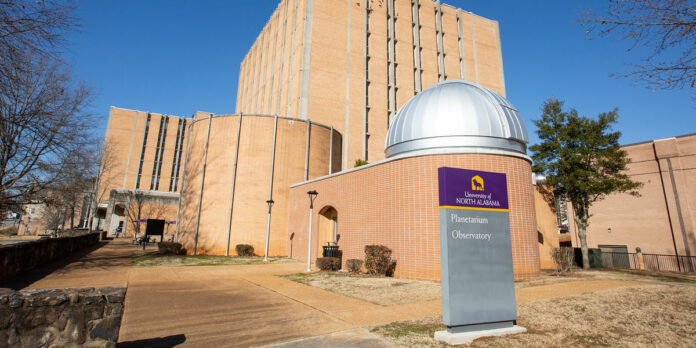FLORENCE — If you miss Tuesday’s total lunar eclipse, you’ll have to wait until March 2025 to catch the next one.
However, the University of North Alabama Planetarium is here to make sure that doesn’t happen.
The UNA Planetarium will have telescopes available from 3-6:20 a.m. to view the eclipse, weather permitting.
Lunar eclipses happen as the full moon passes into the shadow of the Earth when the sun, Earth, and moon are all aligned.
“There are several stages of lunar eclipses,” said Dr. Mel Blake, Planetarium Director and Associate Professor of Physics and Astronomy. “The first stage is the penumbral stage, when, from the point of view of an observer on the moon, the Earth only blocks part of the sun. The next stage is the partial-eclipse phase, where parts of the Moon have the light from the Sun entirely blocked.
“The total eclipse stage occurs when the entire Moon is within the Earth’s shadow. After total eclipse, the sequence reverses itself, with a partial eclipse followed by a penumbral stage at the end.”
In a total lunar eclipse, the entire moon falls within the darkest part of Earth’s shadow, or the umbra. When the moon is within the umbra, it will turn a reddish hue. Lunar eclipses are sometimes called “Blood Moons” because of this phenomenon.
“This color is caused by red light passing through the Earth’s atmosphere and hitting the Moon’s surface and reflecting back to us,” Dr. Blake said. “Lunar eclipses were often thought to be harbingers of doom, heralding the death of a ruler or a coming disaster. The full Moon in November is also called the Beaver Moon so it will be a Beaver Blood Moon.”
According to NASA, the moon turns red because the only sunlight reaching it passes through Earth’s atmosphere. Dust or clouds in the atmosphere during the eclipse cause the moon to appear red, “as if all the world’s sunrises and sunsets are projected onto the moon.”
Totality ― the stage when the moon is completely in Earth’s shadow ― will be visible across North and Central America and parts of South America, Asia, Australia, and New Zealand. Alaska and Hawaii skywatchers will be able to see every stage of the eclipse.
From North Alabama, the eclipse will begin at about 2 a.m. with the total eclipse beginning at 4:16 and ending at about 5:40. The second partial eclipse phase will end with the moon setting around 6:20 a.m.
No equipment is needed to observe a lunar eclipse, but a telescope or binoculars will enhance the viewing experience. So take advantage of the Planetarium’s early hours and catch the light show.
For more information, email Dr. Mel Blake, the planetarium director at [email protected]. The Planetarium is off North Pine Street, across from Flowers Hall and near Rice and Rivers residence halls.
Don’t miss out! Subscribe to our email newsletter to have all our smart stories delivered to your inbox.



